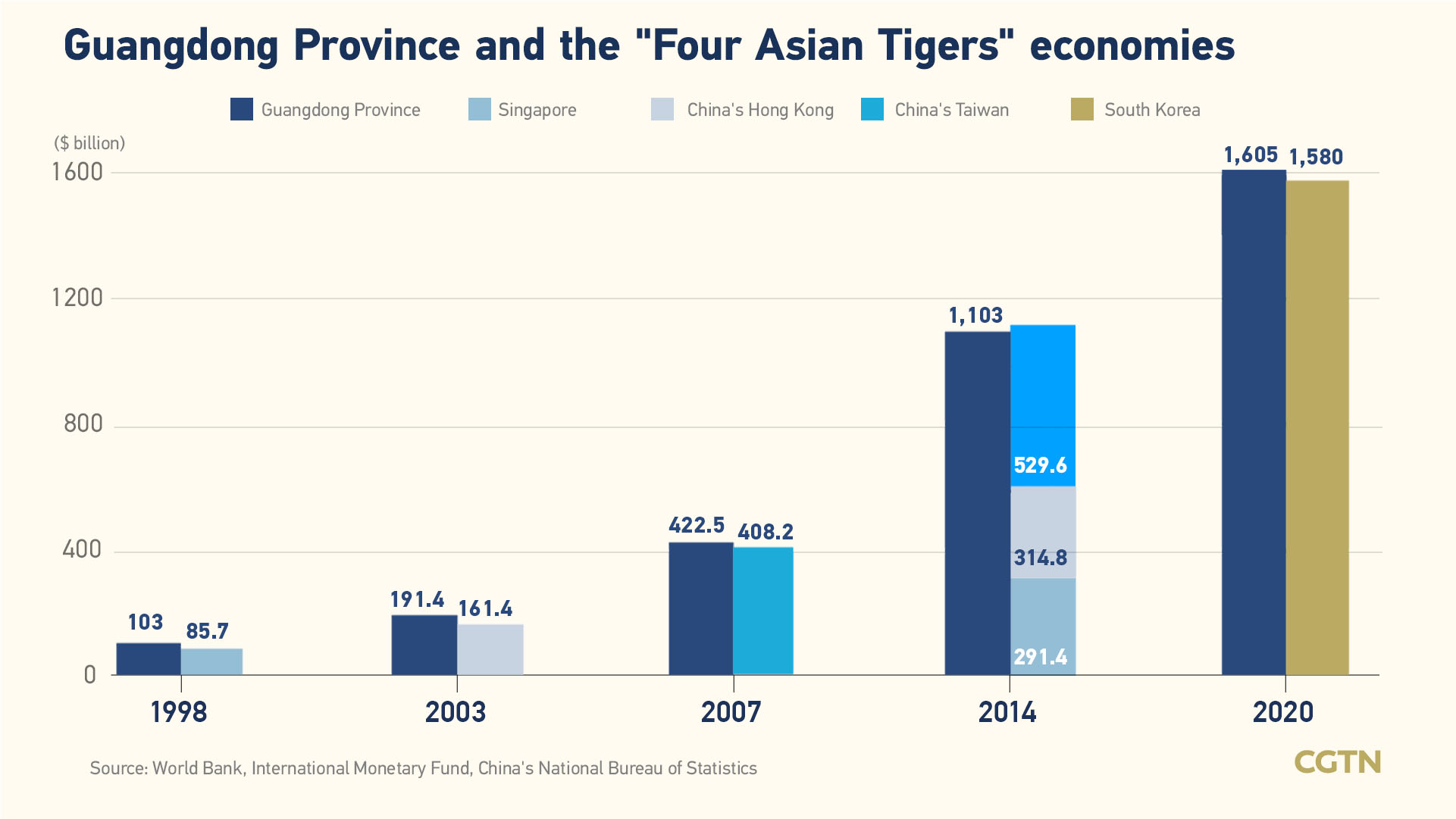
Guangdong is targeting economic growth of more than 6 percent for 2021. /CFP
Guangdong is targeting economic growth of more than 6 percent for 2021. /CFP
The economic output of south China's Guangdong Province may have surpassed that of South Korea – Asia's fourth largest economy – in 2020.
Guangdong's GDP ticked up by 2.3 percent to cross the 11-trillion-yuan threshold in 2020, its governor Ma Xingrui said on January 24.
The average value of the central parity rate of the Chinese currency renminbi against U.S. dollars stood at 6.8974 for 2020, said China's Ministry of Commerce. Based on this, Guangdong's GDP came in at $1.6058 trillion.
As the earliest region in China to ride the wave of reform and opening-up, Guangdong Province has been a role model for the country's rapid economic strides since 1987.
During his inspection tour of southern China from January to February 1992, Deng Xiaoping, the late Chinese leader – also chief architect of China's reform and opening-up blueprint – encouraged Guangdong to catch up with the "Four Asian Tigers," comprising China's Hong Kong and Taiwan, Singapore, and South Korea, and take the lead in realizing modernization.
From then on, the province's economic aggregate exceeded Singapore in 1998, China's Hong Kong in 2003, and China's Taiwan in 2007. In 2014, Guangdong's economic output was almost equivalent to that of Singapore, Hong Kong, and Taiwan combined.
South Korea was tipped to see its GDP shed by 1.8 percent to $1.54 trillion for 2020, occupying the 9th spot in the world, according to the Organization for Economic Cooperation and Development last August.
It was also reported Tuesday that South Korea's economy contracted by 1 percent in 2020 from a year earlier, according to the Bank of Korea, posting the first contraction in 22 years owing to the onset of the COVID-19 pandemic.
South Korea's economic output in 2019 totaled $1.64 trillion, according to World Bank data. The country's GDP stood at $1.58 trillion in 2020, according to Yicai Media Group.
The dust has not settled yet as to whether Guangdong's GDP surpassed that of South Korea.

Peng Peng, executive president of Guangdong Institutional Reform Research Association, said in an interview that Guangdong notched a swift snapback from the lingering pandemic, thus surpassing South Korea in terms of GDP at a faster clip.
Nonetheless, even if the province's GDP exceeded that of South Korea, its per capita GDP is merely half of South Korea's, as Guangdong's population is more than twice that of the developed country. In addition, the Chinese province is still behind in bridging the gap between public services and rural revitalization as compared to South Korea.
Only seven out of Guangdong's 21 prefecture-level cities are kitted out with per capita GDP above the national average, all in the Pearl River Delta region.
Among the 21 cities, Meizhou, with the lowest per capita GDP in Guangdong in 2019, saw its per capita GDP stand at a mere 27,096 yuan – 38 percent of the national average – while Heyuan and Jieyang stood at less than half of the national average.
Guangdong's 2020 GDP is also likely to be higher than that of Australia, the Netherlands, Russia and Spain, to name a few, whose 2019 GDP came in at $1.39 trillion, $0.91 trillion, $1.69 trillion and $1.39 trillion, respectively. The province similarly outshone all other provinces in China for the 32nd year running.
Never before in history has the manufacturing hub that leads foreign trade in the country pocketed such star-spangled economic performance as it is today. It is also the only Chinese province with an economic output exceeding the 11-trillion-yuan mark.
Guangdong's foreign trade to the tune of 7.08 trillion yuan last year took the crown in the country by constituting 22 percent of the world's second largest economy's total trade. Exports climbed by 0.2 percent to remain on the growth track for 4 consecutive years, local customs data showed.
Guangdong is targeting economic growth of more than 6 percent for 2021 as a whole new ball game kicks off.
As a whole, China reported a GDP uptrend of 6.5 percent in the fourth quarter of 2020, bringing the country's full-year expansion to 2.3 percent. Its full-year GDP exceeded 100 trillion yuan ($15.45 trillion) for the first time, China's National Bureau of Statistics said.
As the onset of COVID-19 sent the global economy into one of its worst recessions ever, China is likely to be the only major economy with positive growth in 2020, according to the International Monetary Fund.

